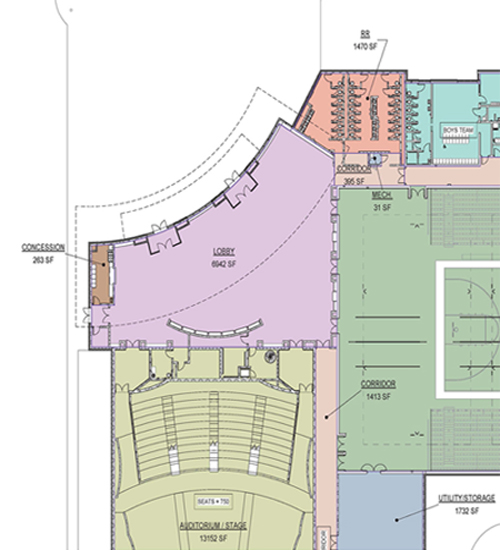Designing For What’s Not There
Author Tony Leininger

I’ve spent my entire professional career listening carefully to my clients in hopes of truly understanding their needs and wants, for their upcoming construction project. This may sound easy but let me assure you it takes a certain amount of patience and perseverance to successfully translate an owner’s scope of work into a built product. Let’s face it, it’s serious business developing someone’s vision and dreams. So, if it takes a certain amount of care and attention to design for what is known, have you ever considered what it takes to design for the unknown? Imagine designing for what’s not there.
Designing
Our design firm, CARMI Design Group, was recently given that very challenge with a commission to design a new Arts and Athletic Center (AAC) in the heart of the Berrien Springs Public School’s campus. We were charged with designing a 77,000 square-foot facility between their existing High School, which would ultimately become the Middle School, and the future High School to be built on the opposing side. It’s important to point out our owner is not expecting to develop the future High School for another 10 years. And so, it begins – “designing for what’s not there.”

Berrien Springs Public Schools Present & Future

Common Lobby
Shared Spaces
The objective was to maximize the AAC’s developed area by sharing a competition gymnasium and performance auditorium between two facilities. A common lobby connects the athletic and the fine arts side of the development in phase 1 and then finally joins the future high school in phase two.
Site Considerations
So, what needs to be considered when designing for what’s not there? Land acreage availability, site utility infrastructure, and circulation are perhaps three of the most important site development factors when designing for a future project. Will we have ample room for the building footprint? Will we have adequate primary power, water, sewer, stormwater collection and technology to service our building? And finally, after planning for the building footprint, will we have enough land remaining for vehicular access, pedestrian walkways, and parking? Let’s not forget that we were only commissioned to design for phase 1, the Arts and Athletic Center, but since this will ultimately be a multi-phase project, it’s necessary to consider all site development factors for both phases

Walkways On Campus

Designing For What's Not There
Building Considerations
Now that we’ve considered the site let’s study the provisions necessary for the building itself. Structural compatibility, exterior finish interface and internal circulation will be important to investigate. How will our roof and wall structure receive phase 2 construction of the future high school? Will the exterior wall finishes of both phases of work be complementary?
The most complex design consideration when focusing on a phased building project is circulation. Obviously, the circulation paths within the AAC were programmed, designed for and scrutinized. The future High School, on the other hand, is anyone’s best guesstimate. What will be the contiguous area functions of phase 2? In this particular case another shared function would make sense because it would connect with the common Lobby between the Middle School and the High School. But what shared function will it be? Cafeteria? Media Center? Virtual Learning Center? Each of these options provide different circulation challenges which will predetermine the primary circulation paths of the future High School.
Height, Scale, and Massing
Although not a part of the current commissioned project, forecasting for height, scale and massing of the future High School was a necessary consideration as well. Will phase 2 be a one-story facility or two-story? If two-story, vertical circulation becomes as important as horizontal circulation with stairs and elevators. When we begin to introduce more than one level to our buildings in a campus setting, height, scale and massing requires study. Building height and location must be carefully considered and situated because of the intimate scale of the campus. By being respectful to the low-density residential neighborhoods contiguous with the campus, taller buildings should be located toward the interior, or heart, of campus. Specific to our AAC project, will the scale of the Arts and Athletic Center and the future High School be compatible? The scale and massing of future buildings must also be designed to maximize the amount of natural light opportunities and visual relationship with the outdoors. To this point, an outdoor learning area naturally developed between the existing High School and the Arts and Athletic Center. Orientation and the sun’s path were studied to insure a pleasant outdoor space.

Forecasting the Future
Designing for what’s not there or the unknown often resembles predicting the future, which is not an easy task. How many students is the district expected to have in ten years? How many times will the teaching curriculum re-invent itself in ten years? What will school funding look like in ten years? Very few of us have a clear enough crystal ball to forecast the future and consequently many design professionals find phased work the most difficult in the business.
If you’re a multi-facility owner looking to develop phased work on your campus, contact CARMI Design Group for professional guidance with designing for the unknown.